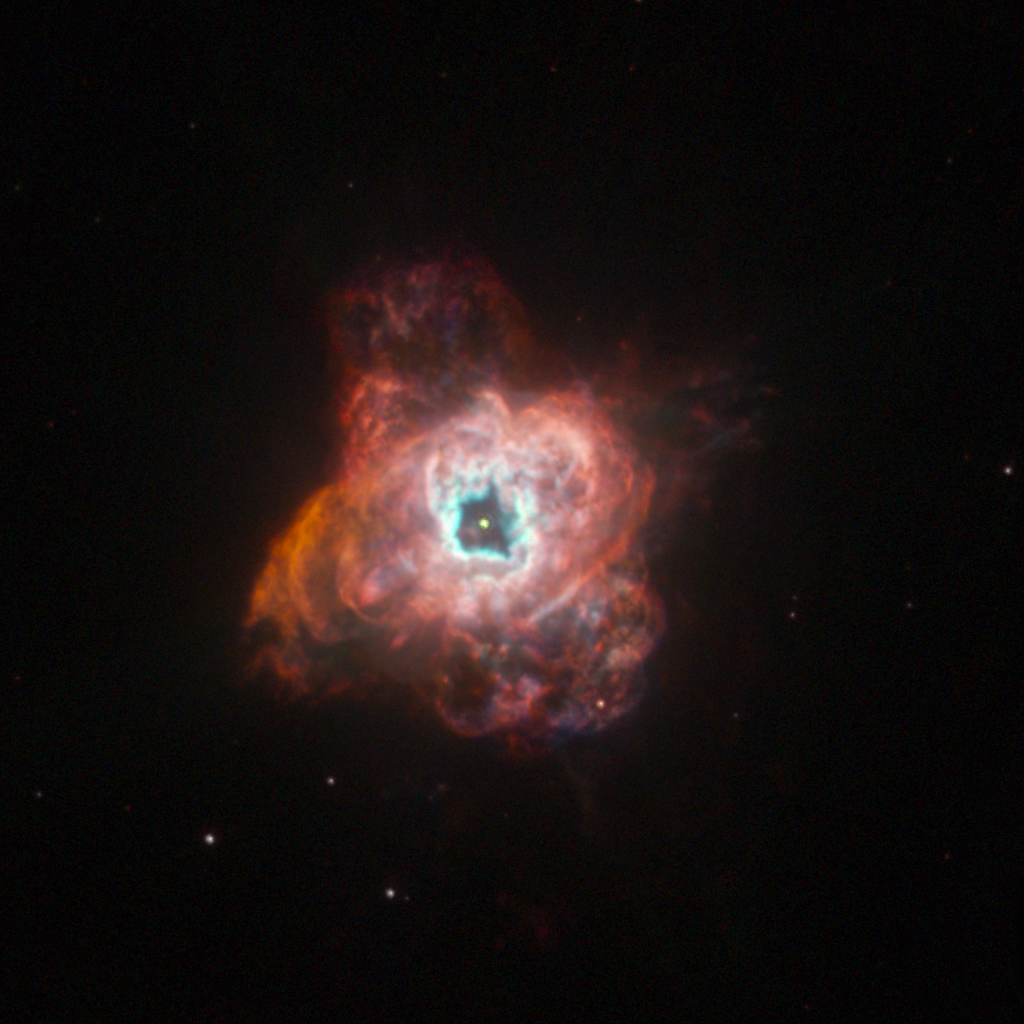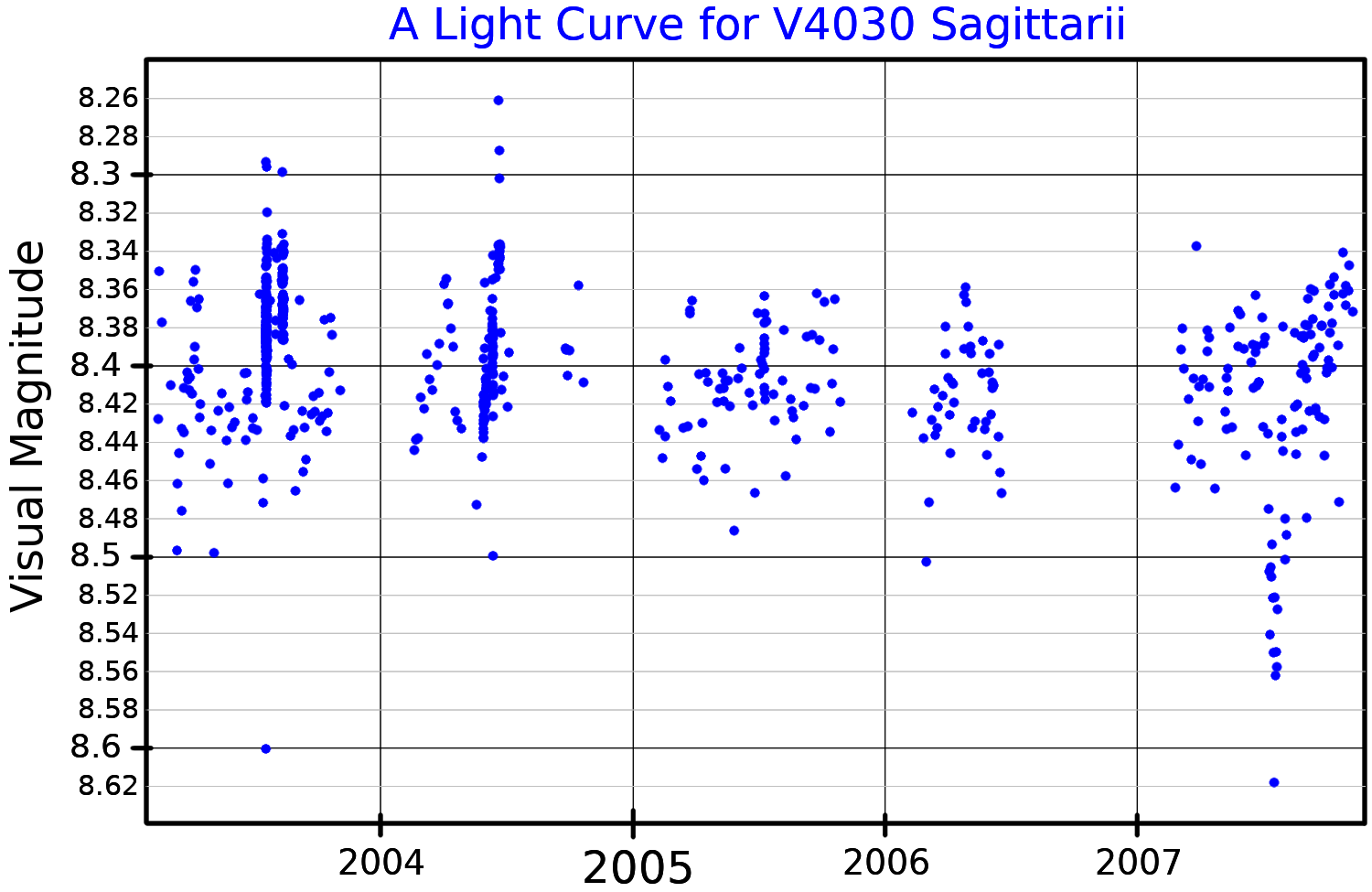|
MN18
MN18 is a blue supergiant in the constellation of Circinus, about 5.6 kiloparsecs away, or about 18,300 light years away, likely in the open cluster Lynga 3. MN18 is surrounded by a bipolar nebula, quite uncommon around blue supergiants, and some other examples of blue supergiants with bipolar nebulae include HD 168625, Sher 25 Sher 25 is a blue supergiant star in the constellation Carina, located approximately 25,000 light years from the Sun in the H II region NGC 3603 of the Milky Way. It is a spectral type B1Iab star with an apparent magnitude of 12.2. ... and SBW 1. Properties Fitting the star's spectrum with synthetic models suggests that it has a temperature of around 21,100 K. Assuming an absolute magnitude of -6.8 (typical for B1 supergiants) and its temperature, it probably has a luminosity around 260,000 times that of the Sun, and so it's probably about 38.5 times the size of the Sun. These parameters can be mostly replicated with a model of ... [...More Info...] [...Related Items...] OR: [Wikipedia] [Google] [Baidu] |
Circinus
Circinus is a small, faint constellation in the southern sky, first defined in 1756 by the French astronomer Nicolas-Louis de Lacaille. Its name is Latin for compass (drawing tool), compass, referring to the Technical drawing, drafting tool used for drawing circles (it should not be confused with Pyxis, a constellation that represents a mariner's compass which points north). Its brightest star is Alpha Circini, with an apparent magnitude of 3.19. Slightly variable star, variable, it is the brightest rapidly oscillating Ap star in the night sky. AX Circini is a Cepheid variable visible with the unaided eye, and BX Circini is a faint star thought to have been formed from the merger of two white dwarfs. Two sun-like stars have planetary systems: HD 134060 has two small planets, and HD 129445 has a Jupiter-like planet. Supernova SN 185 appeared in Circinus in 185 AD and was recorded by Chinese observers. Two novae have been observed more recently, in the 20th century. The Milky ... [...More Info...] [...Related Items...] OR: [Wikipedia] [Google] [Baidu] |
Circinus (constellation)
Circinus is a small, faint constellation in the southern sky, first defined in 1756 by the French astronomer Nicolas-Louis de Lacaille. Its name is Latin for compass, referring to the drafting tool used for drawing circles (it should not be confused with Pyxis, a constellation that represents a mariner's compass which points north). Its brightest star is Alpha Circini, with an apparent magnitude of 3.19. Slightly variable, it is the brightest rapidly oscillating Ap star in the night sky. AX Circini is a Cepheid variable visible with the unaided eye, and BX Circini is a faint star thought to have been formed from the merger of two white dwarfs. Two sun-like stars have planetary systems: HD 134060 has two small planets, and HD 129445 has a Jupiter-like planet. Supernova SN 185 appeared in Circinus in 185 AD and was recorded by Chinese observers. Two novae have been observed more recently, in the 20th century. The Milky Way runs through the constellation, featuring prom ... [...More Info...] [...Related Items...] OR: [Wikipedia] [Google] [Baidu] |
Blue Supergiant
A blue supergiant (BSG) is a hot, luminous star, often referred to as an OB supergiant. They have luminosity class I and spectral class B9 or earlier. Blue supergiants are found towards the top left of the Hertzsprung–Russell diagram, above and to the right of the main sequence. They are larger than the Sun but smaller than a red supergiant, with surface temperatures of 10,000–50,000 K and luminosities from about 10,000 to a million times that of the Sun. Formation Supergiants are evolved high-mass stars, larger and more luminous than main-sequence stars. O class and early B class stars with initial masses around evolve away from the main sequence in just a few million years as their hydrogen is consumed and heavy elements start to appear near the surface of the star. These stars usually become blue supergiants, although it is possible that some of them evolve directly to Wolf–Rayet stars. Expansion into the supergiant stage occurs when hydrogen in the core of the sta ... [...More Info...] [...Related Items...] OR: [Wikipedia] [Google] [Baidu] |
2MASS
The Two Micron All-Sky Survey, or 2MASS, was an astronomical survey of the whole sky in infrared light. It took place between 1997 and 2001, in two different locations: at the U.S. Fred Lawrence Whipple Observatory on Mount Hopkins, Arizona, and at the Cerro Tololo Inter-American Observatory in Chile, each using a 1.3-meter telescope for the Northern and Southern Hemisphere, respectively. It was conducted in the short-wavelength infrared at three distinct frequency bands ( J, H, and K) near 2 micrometres, from which the photometric survey with its HgCdTe detectors derives its name. 2MASS produced an astronomical catalog with over 300 million observed objects, including minor planets of the Solar System, brown dwarfs, low-mass stars, nebulae, star clusters and galaxies. In addition, 1 million objects were cataloged in the ''2MASS Extended Source Catalog'' (''2MASX''). The cataloged objects are designated with a "2MASS" and "2MASX"-prefix respectively. Catalog The final d ... [...More Info...] [...Related Items...] OR: [Wikipedia] [Google] [Baidu] |
HD 168625
HD 168625 (V4030 Sagittarii) is a blue hypergiant star and candidate luminous blue variable located in the constellation of Sagittarius easy to see with amateur telescopes. It forms a visual pair with the also blue hypergiant (and luminous blue variable) HD 168607 and is located to the south-east of M17, the Omega Nebula. Distance The distance of HD 168625 and its association with the Omega Nebula and HD 168607 is in doubt; while some authors think both stars are physically associated and belong to the stellar association Serpens OB1, at a distance to the Sun of , or for both per Gaia Data Release 2 about , a 2002 study estimates this star is farther, at about and unrelated to the other two objects. Physical characteristics Assuming a distance of 2.2 kiloparsecs, the star would be 220,000 times brighter than the Sun, having a surface temperature of 12,000 K. At that distance it can be calculated to be losing mass through a fierce stellar wind at roughly per ye ... [...More Info...] [...Related Items...] OR: [Wikipedia] [Google] [Baidu] |
Sher 25
Sher 25 is a blue supergiant star in the constellation Carina, located approximately 25,000 light years from the Sun in the H II region NGC 3603 of the Milky Way. It is a spectral type B1Iab star with an apparent magnitude of 12.2. Its initial main sequence mass is calculated at 60 times the mass of the Sun, but a star of this type will have already lost a substantial fraction of that mass. It is unclear whether Sher 25 has been through a red supergiant Red supergiants (RSGs) are stars with a supergiant luminosity class ( Yerkes class I) of spectral type K or M. They are the largest stars in the universe in terms of volume, although they are not the most massive or luminous. Betelgeuse and Ant ... phase or has just evolved from the main sequence, so the current mass is very uncertain. The name derives from the original cataloguing of stars in NGC 3603 by David Sher. This catalogue entry is more fully referred to as NGC 3603 Sher 25 to distinguish it from stars ... [...More Info...] [...Related Items...] OR: [Wikipedia] [Google] [Baidu] |
SBW 1 , Singapore
{{Disambiguation ...
SBW may refer to: * A series of aircraft manufactured by Canadian Car and Foundry * SBW (software), a distributed workbench for systems biology modeling * Sonny Bill Williams (born 1985), New Zealand rugby international and heavyweight boxer * IATA designation for Sibu Airport * ICAO designation for Snowbird Airlines * MRT station abbreviation for Sembawang MRT station Sembawang MRT station is an elevated Mass Rapid Transit (MRT) station on the North-South line (NSL). Located in Sembawang, Singapore along Sembawang Road, the station is close to the Sun Plaza shopping centre and Sembawang Bus Interchange. T ... [...More Info...] [...Related Items...] OR: [Wikipedia] [Google] [Baidu] |





